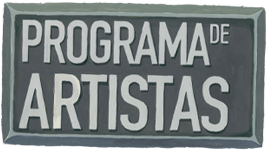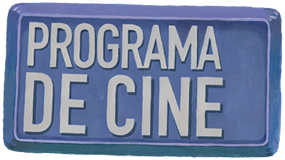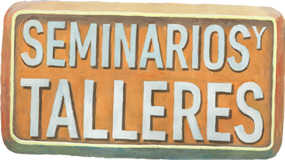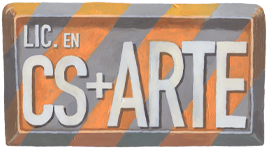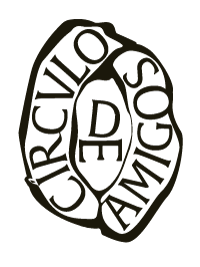Art Department
The Art
Department’s curriculum encompasses:
• Artists’ Program
• Film Program
• Courses including curatorial and studio classes
• Exhibitions
• Seminars, conferences and symposia
These programs are geared to artists, curators, and critics in training who want to work in a context committed to intellectual and creative stimulation.
The professors engage in constant dialogue with the participating artists. Their varied approaches to contemporary art encompass critical analysis, historical knowledge, theoretical discussion, and experimentation. Faculty members include and have featured Jorge Macchi, Javier Villa, Santiago García Navarro, Karina Peisajovich, Marcelo Pombo, Eduardo Stupía, Matías Duville, Alberto Goldenstein, Claudio Iglesias, Graciela Speranza, Diego Bianchi, Alejandro Meitin, Lars Bang Larsen, Valentina Liernur, Carlos Huffmann and Martí Manen.
Together, we hope to transform artistic culture by commiting to education that rethinks the definition of art and its role in contemporary society.
| Artists' Program |
The Artists’ Program is a space for artists, critics, and curators interested in participating in an intensive experience featuring discussion, theoretical courses and production in a university context. For a year and a half, the 25 selected participants will take part in a series of workshops, seminars, lectures, and visits by local and international professors. They will be provided with a shared studio to gather and work on group and individual projects. Participants in the program must commit to attending classes at least three afternoons a week and to engage in collaborative work. All courses are held in spanish, so applicants should have a basic knowledge of the language. The 12th edition of the program, to be held in 2020, will look into the mechanics of how a work of art produces intensity and meaning. This implies a focus on the unique material characteristics of the artwork, its interactions with verbal discourses and theoretical frameworks, how it is conceptualized, and how it is articulated into the physical and social space. The program will be structured around the annual group critique coordinated by Jorge Macchi, Marcelo Pombo and Josefina Carón. The Critique is a space for in-depth discussion of the proposals from the participating curators, critics, and artists. During the first part of the year, the artist and director of the Art Department Carlos Huffmann will teach the Extraña Materia seminar. It will examine the intersection between material/visual language and discursive/verbal language. The tension between them as the engine that produces the artistic experience will be examined in assigned readings, hands-on exercises with simple materials, and visits to exhibitions. Throughout the year, a series of technical/authored workshops will be offered to participants in the Program and to a limited number of individuals from the general public. The workshops will focus on a specific aspect of the teacher's praxis, such as painting, animation, digital photography, and others. They explore how an artwork’s material characteristics and conditions of production determine what the work does upon reception. Sebastián Gordin, Mónica Heller, Juliana Iriart, Juan Tessi and Rosana Schoijett will direct these workshops. Three elective theoretical seminars, taught by Tomás Borovinsky, Mariana Dimópulos and Graciela Speranza, will be offered to Program participants and the general public. During August 2020, US art critic David Joselit will be giving a closed seminar on painting as language and vehicle of social interaction, and a public conference on his work. He will also meet the participants and make studio visits. The selected critics and curators will participate in the Program alongside the artists, fostering an ecosystem of material and discursive production that includes all of the primary players in contemporary art, an indisputably collective phenomena. Critics and curators in the program as well as members of the general public can participate in a series of Curatorial Units with classes on the history of exhibitions, theoretical debates, a legal seminar, and other pertinent topics. Lara Marmor, Cintia Mezza, Lucrecia Palacios, Fernanda Pinta, and Ivan Rosler will direct these units. The 12th edition of the Artists’ Program will take place from March to December, 2020, and from March to June, 2021. The final semester includes a critical art writing workshop and will also focus on working with various tutors on the Final Project to be carried out in June 2021. No previous degree is required to apply. The application consists of a portfolio of works on the basis of which an admission committee selects participants. With the exception of seminars given by international professors, the program is given in Spanish. |
| Film Program |
The Film Program proposes a space of production and reflection for filmmakers, visual artists, photographers, writers, researchers, dramatists interested in exploring cinema as a multidisciplinary territory. This
program has a central seminary for
analysis of the works, that functions as a permanent workshop where participants engage in weekly practice exercises –
in the spirit of trial and error. In addition to including an intense exchange between participants from different disciplines and trajectories (without age limitations), this Program includes instances of exchange with the participants of the Artists’ Program within the framework of the Art Department.
IMPORTANT: The program is intensive and requires that the participants undergo a serious commitment during its 8 months of duration. Participants must have time to attend weekly classes, monthly presentations and intensive seminars (in different dates), and additional time to carry out practical work. |
| Theory Workshops and Courses |
Workshops Much contemporary art education is based on the critical, speculative or contemplative analysis of a work in progress by a professor. The workshops in our program consciously formulate a pedagogical alternative to that model by focusing on group immersion in techniques. The premise is training, production, specific thought. Each workshop meets twelve times and revolves around the idea of an exercise in which students are asked to leave their individual production aside to delve into individual or group research in techniques, ideas, and resources foreign to their prior production. Enrollment in workshops is open to students in the Artists’ Program and others interested in participating. Curatorial Studies and Art Criticism This program, which began in 2013 as a new phase of the Artists’ Program, is intended to be an intensive experience in different modes of production and discussion pertinent to the visual arts. It is geared to providing participants with critical and curatorial tools crucial to working in contemporary art. No degree is required to enroll, but it is envisioned for those who have studied or hold degrees in art history, art, literature, philosophy, communication, or architecture. In all cases, participants must show an interest in developing critical skills to think, interpret, assess, and exhibit different facets of the visual art. Unlike most curatorial programs, this one not only attempts to convey knowledge on theory and on the history of art and exhibitions, but also to provide a shared experience with a group of active artists. As such, it formulates total and collaborative immersion in artists’ processes, procedures, and ideas. This exchange is the crux of the program. It is designed as training in inter-subjective negotiation and dialogue, which it conceives as central. |
| International Professors |
On the basis of alliances with foreign art institutions and in an effort to complement the work of the local professors, this program invites foreign professors to teach an intensive seminar as part of the department’s activities. These seminars are aimed at participants in the Artists’ Program and other members of the local art community interested in enrolling. The visit usually includes a public lecture where the guest discusses his or her work and its development before an audience of local artists, curators, critics, and historians. The exchange with thinkers and creators from other countries is fundamental to the department’s mission of rethinking the definition of contemporary art and its practices in Argentina. In 2012, the following visiting artists taught in the program: Tracey Emin (England), Renata Lucas (Brazil), Santiago Sierra (Spain), and Franz Ackermann (Germany). Visiting curators were Sofía Hernández Chong-Cuy (United States/Mexico), Ariel Jiménez (Venezuela), and Paulo Hernkenhoff (Brazil). In 2013, we were visited by curators Cuauhtémoc Medina (Mexico), Chus Martínez (Spain/USA), Manuela Moscoso (Ecuador/Brazil), and Mariano Mayer (Argentina/Spain); and artists Guillaume Leblon (France), David Bestué (Spain), Yael Davids (Israel/Brazil), Adriano Costa (Brazil), Karl Holmqvist (Sweden), and Sergio Muñoz Sarmiento (USA). In 2014, the visiting curators and theorists that taught in the program were: Lars Bang Larsen (Denmark), Martí Manen (Spain/Sweden), Bruce Altshuler (USA) and Raimundas Malasauskas (Lithuania/France). |
| Exhibitions |
In the interest of generating a space for research and production of experimental art, the Art Department holds an annual series of exhibitions at a large gallery on the university’s premises. These events are open to the public and feature experimental works by students, Argentine and foreign artists, and special guests. The aims of the exhibition program are: - to grant Argentine and foreign artists, regardless of whether they are affiliated with the university’s programs, with funds to produce new, experimental, and interdisciplinary works that are rarely found in traditional spaces for the circulation and exhibition of art. - to provide the community at large with access to excellent works and exhibitions whose experimental and pedagogical nature stimulates intellectual debate. |
| Support |
To make our programs affordable, they are subsidized by contributions from individuals, companies, and foundations that believe, as we do, in the importance of education as a means to generate Latin American art with greater commitment to contemporary forms of knowledge, debate, and experimentation. The Art Department is funded on an ongoing basis by the Instituto Torcuato Di Tella and the Fundación Torcuato Di Tella; it has also received support from the Foundation for Arts Iniciatives (USA), the Fundación arteBA and Ernesto Catena Vineyards. In 2012 the Círculo de Amigos of the Universidad Di Tella Art Department was created. This organization, which consists of a group of private donors, has contributed to furthering the program’s activities. On many different occasions, the Art Department’s programs have been declared activities of interest by Mecenazgo Cultural, a project of the Buenos Aires city government that selects cultural initiatives for tax-deductible contributions from corporate donors. |
| Scholarship Fund |
Thanks to donations, we have been able to make tuition affordable to local artists. The program requires full-time commitment. By offering excellent post-graduate education at low tuition, we ensure that all interested individuals, regardless of their economic situation can apply. |
| International Agreements |
In the interest of making the Artists’ Program more international, the Art Department has signed agreements with two Latin American institutions that grant scholarships to young artists from their countries so that they can travel to Buenos Aires and participate in the program. Thanks to scholarships from the Fundación Iberé Camargo of Porto Alegre (Brazil), Brazilian artists Cristiano Lenhardt participated in the program in September 2011 and Fernanda Gassen in 2012. Thanks to scholarships from MALI (Museo de Arte de Lima Peru), Peruvian artists Emilio Vargas Vera participated in the program in 2011 and Luis Antonio Torres Villar in 2012. Pursuant to selection by a bi-national jury, each artist took part in the Artists’ Program for a period of three months. Son Sard Trust, one of the only funds in Argentina that helps women artists fund studies in Europe, decided to allocate one of its fellowships through the Artists’ Program. |
| Director |
Carlos Huffmann (2018-present) Carlos Huffmann obtained his Masters of Fine Arts from the California Institute of the Arts (CalArts) in 2015. He has a Bachelor’s Degree in Business Economics from Universidad Torcuato Di Tella from which he graduated in 2001. In 2001 he received a mention in the first edition of ‘Curriculum Cero’ in the Argentinean gallery Ruth Benzacar. He studied arts in the workshops of Pablo Siquier (2002), Mónica Girón (2000-2002) and Diana Aisenberg (1999-2001). In 2015 he participated in the Residence ArtOMI (International Arts Center) in Ghent, New York. Huffmann carried out various solo exhibitions such as ‘Materia, Forma y Poder’ (Gallery Ruth Benzacar, Buenos Aires, 2017), ‘Holograma’ (Mite Gallery, Buenos Aires, 2016), ‘Nuevos Trabajos’ (SIM Gallery, Curitiba, 2014), ‘Relicario de Caballito’ (installation piece in a non-institutionalized space, 2014), ‘Juventud de los Ancestros’ (Gallery Ruth Benzacar, Buenos Aires 2012), ‘Si fueses un personaje de novela tendrías la misma cicatriz’ (Centro Cultural Recoleta, Buenos Aires, 2011), ‘Extraño gobernante para un corazón’ (Alberto Sendrós Gallery, Buenos Aires, 2009), ‘LejanoExtremoUltraCentro (Luis Adelantado Gallery, Valencia, 2008) among others. He has also participated in several group shows such as Dixit:2016, Premio Braque, 2015, ‘Las Bestias’ (MACRO Museum in Rosario, 2012), ‘Historias de la A: Obras de la colección Jumex’ (Amparo Museum, Puebla, 2011), ‘Narrativas Inciertas’ (MAMBA, Buenos Aires, 2011), ‘Blemish’ (Luis Adelantado Gallery, Miami, 2006), ‘Travelling Show’ (Colección Jumex, Mexico City, 2010). Founder and former director (2008-2018): Inés Katzenstein was awarded a master’s degree from the Center for Curatorial Studies, Bard College, New York in 2001 pursuant to studies funded by the Fundación Antorchas and the Fondo Nacional de las Artes. She has written extensively on contemporary art. The major exhibitions she has curated include Liliana Porter: Fotografía y ficción (Centro Cultural Recoleta, Buenos Aires, 2003), David Lamelas, Extranjero, Foreigner, Ètranger, Aüslander (Museo Rufino Tamayo, Mexico, 2005); she co-curated Televisión, El Di Tella y un episodio en la vida de la TV (Espacio Telefónica, 2010). She was the curator of the Argentine pavilion at the 52nd Venice Biennale, where she presented the project Guillermo Kuitca, If I Were Winter Itself. She co-curated Zona Franca, MERCOSUR Biennial, 2007. Her publications include the book Listen, Here, Now! Argentine Art of the Sixties: Writings of the Avant-Garde, The Museum of Modern Art, New York, 2004, which was translated into Spanish and published by MoMA in conjunction with Fundación Espigas and Fundación Proa (2007). She won awards from the Argentine Association of Art Critics in 1997 and 2006 for an essay on Pablo Siquier and an interview with Marcelo Pombo, respectively. From 2004 to 2008, she was the curator at Malba-Fundación Costantini, Museo de Arte Latinoamericano de Buenos Aires, where her activities included developing the collection of contemporary art. She sits on the advisory board to the magazine Otra Parte de Artes y Letras. She is currently the inaugural director of the Patricia Phelps de Cisneros Research Institute for the Study of Art from Latin America at the Museum of Modern Art in New York where she also works as a curator on Latin American Art.
Board of External Advisors Advisory Board Bachelor’s Degree in Visual Arts Board |
For further information, contact arte@utdt.edu

